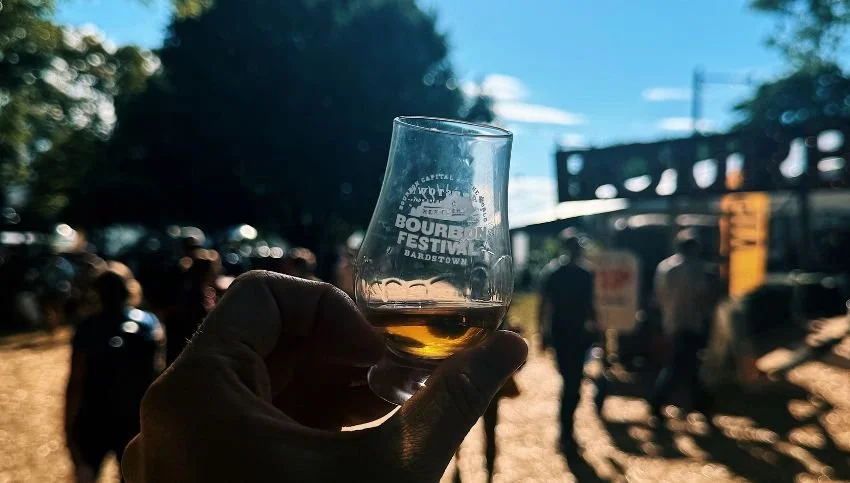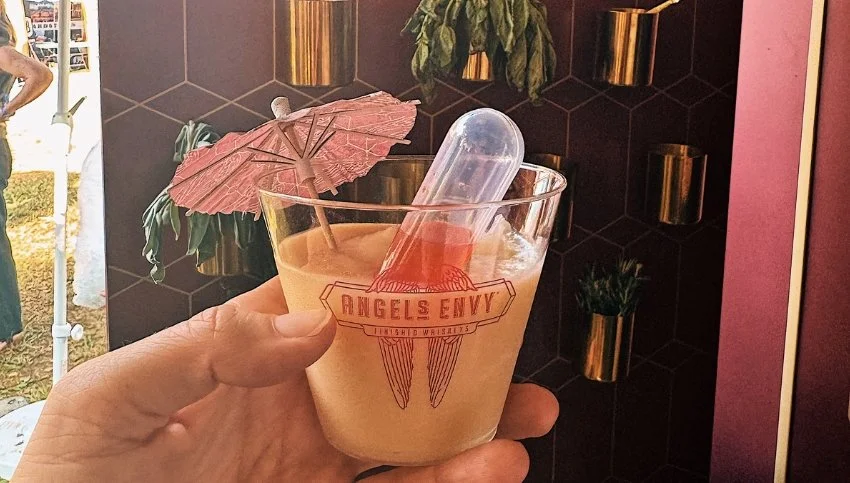Four things the UK whisky community can learn from the Kentucky Bourbon Festival
Enjoying a whiskey at KBF
The Kentucky Bourbon Festival brought all the vibes, good times, and of course, whiskey. And the whole atmosphere felt strikingly different to UK whisky events. Here’s what the community on this side of the pond, from organisers and brands to guests, can learn from it.
The storm clouds had started to part by the time we set off for Bardstown. Which was a very good thing. Louisville had received a drenching that morning as the remnants of Hurricane Francine made her presence felt. An hour further south, the Kentucky Bourbon Festival (KBF) organisers must have been thanking their lucky stars as the open-air show avoided the deluge. Instead, the sun came out as we sped through the rolling Kentucky countryside, catching sight distilleries like Jim Beam along the way. The stage was set for the 2024 edition of one of the world’s most exciting whisk(e)y events.
KBF has relatively humble origins. It officially kicked off in 1991 when 250 people gathered for a whiskey dinner. Today it draws close to 50,000 people to Bardstown each year, according to organisers. The town, home to around just 6,000 people, swells as visitors from around the world touchdown in the ‘Bourbon Capital’. It also sees the World Championship Bourbon Barrel Relay take place. If rumours are to be believed, the gloriously chaotic display of strength and speed is about to see a huge cash injection from a major broadcaster as efforts are made to grow the sport.
It’s about as major as it gets in the global whisky calendar. And when I was offered the opportunity to attend as part of the IWSC North America Judging I jumped at the chance. Even better, my partner Rosie was able to come too. She loves whisky of all kinds, but doesn’t work in the industry. I was thrilled to join in the fun, and also excited to see it all through her eyes, too.
Whisky festivals: pros and cons
But then a sense of anxiety crept in. I’ve intentionally avoided whisky festivals here in the UK for a number of years now. In fact, I can’t remember going to one this side of the pandemic. As a whisky writer, and someone who genuinely loves the spirit both inside and outside of work, it seems like an odd choice. But honestly, in my experience the positive elements (and there are very many!) are depressingly often eroded away by the cons. The scrums for drams. The number of clearly very intoxicated people and their erratic behaviour. And, sadly, it seems to me that events bring the misogyny still inherent in whisky to the surface. There’s sexism (“do you even like whisky though?”) and then there’s harassment. It got to the point that I’d just rather not bother. And I say this as someone usually lucky enough to be able to access a press or trade ticket. Would I pay £100 for the privilege of being in such an uncomfortable situation? No thanks.
Would KBF be the same? I was worried that it could be. Factor in the current political climate in parts of the US (this post on Brown-Forman’s rollback of DEI policies will give some idea), and I was also concerned about going with my lesbian partner. Turns out, there was zero cause for anxiety. In fact, KBF was one of the safest, most inclusive whisky events I’ve ever been to.
The open-air setting was especially refreshing. Obviously there’s a risk that comes with this. It would be near-impossible to plan something similar outside in the UK. Even in Kentucky, Hurricane Francine tried to have a say! So I’m taking that element out of the comparison. (KBF has an unfair advantage here – there’s nothing quite like sipping bourbon in a sun-dappled spot on a glorious day). But there were other factors, too. The breadth of food on offer. The easy availability of water. And then there’s the demographic of the audience! Yes, it still skewed very white. But I’ve never seen such a wide representation of age or gender at a whisky event before. More of this please.
With all that in mind, here are four things I think the UK whisky community can learn from KBF. Because we all have a responsibility to change the culture of events here, organisers, brands and guests alike.
There just weren't any scrums!
Lesson 1: It’s not a race for mass consumption
An element of KBF that really struck me was the orderly queuing at stands. Wherever you were in the grounds, from the craft makers to the big names, there were polite lines. Not one single scrum around a brand. No tasting glasses in the air, high like the beaks of starving baby birds demanding to be fed. There was patience. Calm. Space for chat and discussion. It is sad that this was so striking.
To me, it speaks to a markedly different drinking culture. Consumption was mindful. Tasting was considered. I suspect it was partly ticket-holders prioritising whiskeys that they were really interested in. There was none of that ‘need to get your money’s worth’ mentality that I’ve heard in the discourse around whisky shows here.
Was there a difference price-wise? Not markedly. KBF tickets start at $105 (about £78) for ‘Sunday Sampler’ tickets, while weekend passes sit at $180 ($135). Whisky Show Friday session passes are £85 ($113), while other day tickets are £125 ($168), and weekend tickets are £220 ($294 – these are admittedly more expensive). Early bird Whisky Live London sessions start at £51 ($68), with ‘classic’ tickets at £61 ($82). Drunk, inappropriate behaviour at whisky events is not combined to one type of ticket holder at one show, so we can safely conclude this isn’t down to pricing.
How to tackle the mindset that sampling everything is the way to go? I do think there’s something to be said about encouraging the use of spittoons. I also think we need to make water and food more readily available. And we need to have a lower tolerance for over-consumption. That’s a tricky one, but it’s something for everyone to work on.
One of the joys was seeing more innovative takes on whiskey
Lesson 2: Be more considerate of the people around you
Behave well. That’s it. That’s the lesson. If only it was as simple as that.
This is one for everyone in the whisky community. Because I did not see one incident of inappropriate, unkind, or overly drunk behaviour while we were at KBF. And the whole environment was so much nicer as a result.
Whether it’s organisers, brand representatives or ticket holders, we all need to just look out for each other a bit more. Be patient in queues, yes. But also just be kind. Or at least neutral. Don’t make weird comments about other festival-goers, or assume that you know more than anyone else there. (Yes, that includes when talking to people working on the stands – a known issue.) If someone has over-indulged, take care of them. Don’t be verbally abusive. Don’t impede other people’s enjoyment. And certainly don’t touch anyone without consent. It’s absolutely WILD that these things even need to be stated. But I’ve either experienced each of these issues, or know people to have. Even if you as an individual haven’t seen it, they happen.
Organisers: take this stuff seriously. Have a zero-tolerance approach. Ban repeat offenders. Include a code of conduct on sign-ups. Brands: train your teams. Ticket holders: just be nice! And drink water.
KBF showed me that whisky events themselves are not the problem. So let’s address the behaviour that is.
Lesson 3: Diversify your speaker programme!
One for event organisers, and I’ll keep it brief. Make sure your speaker, panel and tastings line-up includes a broad range of people! Every time I walked past the KBF main stage there was at least one woman on it. If one event can do it, all of them can.
Obviously diversity isn’t just down to gender. And ‘women in whisky’ is perhaps the easiest metric to measure and address. I want to hear from ALL voices in the industry. So let’s make that possible.
Rosie enjoying a cocktail!
Lesson 4: Encourage your friends and family to come too!
Here’s the fun one – and it’s just as important a takeaway. Encourage your friends and family to come to whisky events with you! One of the biggest joys of attending KBF was that there were clearly groups of friends, or even families (21+ obviously!), making a day of it.
I think this is partly where that feeling of a more diverse audience came from. Women weren’t just there with their husbands – they had come with their friends, too. Younger groups were there for the whiskey and the food. And the music.
And the cocktails! The slushies! There was such a sense of fun and enjoyment that extended beyond the neat whiskey. There was space too – the perks of being outside – to gather and sit and chat. KBF felt like a whiskey lifestyle festival, as much as a whiskey festival. And perhaps that’s the key takeaway. Whisky is more than just the liquid in the glass: so let’s make sure our festivals here reflect that.
DISCLOSURE: Our tickets to attend the Kentucky Bourbon Festival were complimentary and through my work with IWSC.




